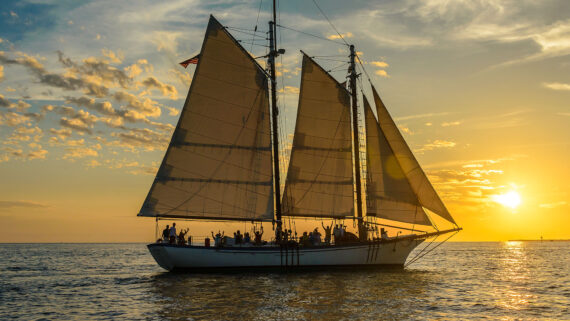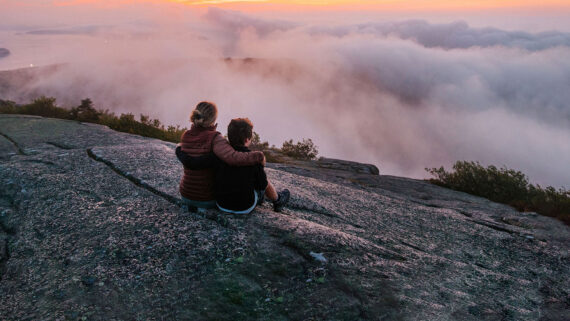
A Beginner’s Guide to Ice Climbing Lake Placid’s Famed Frozen Pitches
Few outdoor winter activities are as thrilling as climbing the frozen waterfalls and cliffs in and around Lake Placid, New York – beginners welcome!
Ice climbing is a big deal in the Adirondacks, especially in and around Lake Placid. For Will Roth, a climbing guide at the EMS Climbing School, it was reading about the mixed ice climbing scene happening in Lake Placid in a climbing magazine that sold him on the area. A seasoned climbing guide who has been all over the country on rock and ice, as well traveled internationally to Peru, Bolivia, Scotland, and France, Roth loves living in the Adirondacks because each new season brings a different type of climbing and a wide variety of weather to embrace. As Roth puts it, “If you can climb in the Adirondacks well, you can climb anywhere well.”
But that doesn’t mean ice climbing here is just for experts. We caught up with Roth to pick his brain about what makes ice climbing in Lake Placid so good, why beginners shouldn’t be intimidated by it, and why it’s his winter activity of choice that keeps him coming back again and again.
Q: What’s your pitch on the appeal of ice climbing?
A: Ice, unlike rock, changes all the time. Much like surfers looking for the swell, ice climbers are looking for the temperature and conditions to line up. That part of being connected to what nature throws at you is what always intrigues me about ice climbing. Ice climbing is a sport that would not be possible without tools. These tools – ice axes, crampons, etcetera – make a sport that would otherwise be impossible, possible. You’re climbing a medium that was not designed to be climbed. But with modern tools, we can climb ice and enjoy it. During the long nights and short days of winter, being outside and participating in a sport like ice climbing just feels so gratifying.
Q: Why is ice climbing around Lake Placid so good?
A: The ice climbing around Lake Placid is so good because it is super reliable and very consistent. Usually by late November, ice is forming, with the second week in December kicking off a season that lasts until the second week of March in the lower elevations and until April in the higher backcountry elevations.
Q: For someone who has never been ice climbing, what would you say to encourage him or her to shake off the intimidation factor?
A: For a beginner ice climber going out with a guide, you’re not at any more risk than rock climbing – and certainly at a lower risk of injury than driving! The cold can make it more uncomfortable, but with the modern technology in active clothing, most people can stay very comfortable even if the temperatures are hovering close to 0°F. Also, going with a guide will help to ensure that the best location for the day’s temperatures is chosen. So, if it’s 0°F with a wind chill making it seem colder, choosing a sunny cliff tucked out of the wind will help to make your day more enjoyable.
Q: What kind of equipment is required?
A: If you go with a guide service, all the technical equipment (boots, crampons, axes, helmet, and harness) should be provided. Personal equipment should be non-cotton clothing – go for under layers made from wool, synthetics, or silk, like you would to go skiing on a very cold day. You’ll also want a larger puffy (down or synthetic fill) jacket, waterproof pants, and several pairs of warm gloves. A thermos, Hydroflask, or water bottle in an insulating sleeve, with warm liquid will make you day go by so much better. Also, lots of high-calorie, easy-to-eat snacks, like GORP, Cliff Bars, etcetera. Stopping to have a sit-down lunch rarely happens.
Q: What are some of the most beginner-friendly routes in the Lake Placid area?
A: The Cascade (WI2) is an excellent beginner multi-pitch climb. Reliable, lower angle, and right off the road, it’s a popular beginner route. However, the approach can be the crux (the most difficult portion of the climb) if the lake is not frozen.
Buster (WI2) is an excellent beginner route with easy bail options (a way to retreat) at almost any time. The final pitch is the crux with many options to avoid most steeper sections.
Chounaird’s Gully (WI3) is a great multi-pitch route that was supposedly first climbed during Yvon Chounaird’s 1969 eye-opening visit to the area. [Chounaird, the founder of Patagonia, was a pioneer of ice climbing and designed the ice ax you see now, which he introduced on that climb in 1969.] The first pitch is the crux but two more long pitches keep you entertained.
Q: What’s the progression in terrain beginners can expect as they get the hang of it?
A: This question is specific to each person. But I’d say that after a long weekend of instruction, a client should be able to climb a beginner multi-pitch route. Multi-pitch intermediate ice climbing takes more time to master and usually requires a few weeks of skills to be comfortable.
Q: What’s the best moment of a climb for you?
A: Topping out on a long, big, backcountry classic, like the Trap Dyke. Especially if it’s a windless, bluebird day!
Where to Stay Lake Placid Lodge




